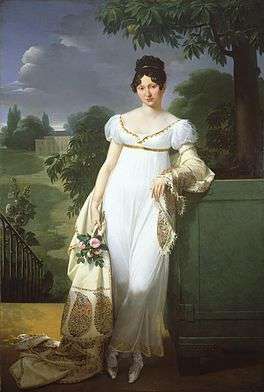Empire silhouette



Empire silhouette, Empire line, Empire waist or just Empire is a style in women's clothing in which the dress has a fitted bodice ending just below the bust, giving a high-waisted appearance, and a gathered skirt which is long and loosely fitting but skims the body rather than being supported by voluminous petticoats. The outline is especially flattering to pear shapes wishing to disguise the stomach area or emphasize the bust. The shape of the dress also helps to lengthen the body's appearance.
While the style goes back to the late 18th century, the term "Empire silhouette" arose over a century later in early 20th-century Britain; here the word empire refers to the period of the First French Empire; Napoleon's first Empress Joséphine de Beauharnais was influential in popularizing the style around Europe. The word "empire" is pronounced with a special quasi-French pronunciation /ɑːmˈpɪər/ by many in the fashion world.[1]
History
The style began as part of Neoclassical fashion, reviving styles from Greco-Roman art which showed women wearing loose fitting rectangular tunics known as peplos or the more common chiton which were belted under the bust, providing support for women and a cool, comfortable outfit suitable for the warm climate.
The last few years of the 18th century first saw the style coming into fashion in Western and Central Europe (and European-influenced areas). In 1788, just before the Revolution, the court portraitist Louise Élisabeth Vigée Le Brun had held a "Greek supper" where the ladies wore plain white "Greek" tunics.[2] Shorter classical hairstyles, where possible with curls, were less controversial and very widely adopted. Hair was now uncovered even outdoors; except for evening dress, bonnets or other coverings had typically been worn even indoors before. Thin Greek-style ribbons or fillets were used to tie or decorate the hair instead.
Very light and loose dresses, usually white and often with shockingly bare arms, rose sheer from the ankle to just below the bodice, where there was a strongly emphasized thin hem or tie round the body, often in a different color. A long rectangular shawl or wrap, very often plain red but with a decorated border in portraits, helped in colder weather, and was apparently lain around the midriff when seated—for which sprawling semi-recumbent postures were favored.[3] By the turn of the century such styles had spread widely across Europe. In France the style was sometimes called "à la grecque" after the decorations found on the pottery and sculpture of Classical Greek art. The adoption of this style led to a drastic contrast between 1790s fashions and the constricting and voluminous styles of the 1770s (with a rigid cylindrical torso above panniers). The change is probably partially due to the French political upheavals after 1789. The early styles often featured entirely bare arms, as in the ancient exemplars, but from about 1800 short sleeves became more typical, initially sometimes transparent as in David's Portrait of Madame Récamier (1800), then puffed. The style evolved through the Napoleonic era until the early 1820s, becoming gradually less simple, after which the hourglass Victorian styles became more popular.
English women's styles (often referred to as "regency") followed the same general trend of raised waistlines as French styles, even when the countries were at war. The style was very often worn in white to denote a high social status (especially in its earlier years); only women solidly belonging to what in England was known as the "genteel" classes could afford to wear the pale, easily soiled garments of the era. The look was popularized in Britain by Emma, Lady Hamilton, who designed such garments for her performances of poses in imitation of classical antiquity ("attitudes"), which were a sensation throughout Europe.[4] The high-waisted cut of the dress was also applied to outer garments, such as the pelisse. The Empire silhouette contributed to making clothes of the 1795–1820 period generally less confining and cumbersome than high-fashion clothes of the earlier 18th and later 19th centuries.
The 1910s saw a revival of the style, added with Oriental motifs, possibly reflecting the less strict social mores of the era, paving way to the unconstricting 1920s "flapper" styles that would replace the heavy corsetry of the early 20th century.
See also
References
Notes
- ↑ Nellis, Cynthia "Empire" on About.com
- ↑ Hunt, 244
- ↑ Hunt, pp. 244–245
- ↑ Charles McGrath, Pretty Words, Jane; Would That You Were Too, New York Times, April 1, 2007.
Further reading
- Bourhis, Katell le: The Age of Napoleon: Costume from Revolution to Empire, 1789–1815, Metropolitan Museum of Art, 1989. ISBN 0870995707.
External links
-
 Media related to Empire silhouette at Wikimedia Commons
Media related to Empire silhouette at Wikimedia Commons